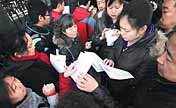
Even in China, there is little evidence to show direct links between M2/GDP ratio and inflation, according to historical records.
For example, from 1993 to 1995, the country's consumer price index (CPI) climbed more than 10 percent but M2/GDP ratio was quite stable around 100 percent. From 1998 to 2002, M2/GDP ratio soared but deflation occurred at the same time.
Xi Junyang, deputy director of Modern Finance Research Center in Shanghai University of Finance and Economics, believed that the ultimate indictor of money oversupply should be prices.
He admitted that China experienced two money over-issuances between 2007 and 2008 and in 2011, when CPI climbed more than 5 percent year on year.
"The real danger for prices is the M2 growth rate," E Yongjian said.
The M2 growth rate normally should be slightly higher than the total sum of the GDP growth rate and inflation rate, said E, who believed "China's forecast for this year's M2 growth rate is relatively reasonable."
The country predicts its M2 will surge 13 percent in 2013, 0.8 percentage points lower than the actual rise last year. It targets 7.5 percent growth in GDP and 3.5 percent growth in inflation this year.
Ha Jiming, chief investment strategist for the investment management division of China at Goldman Sachs, said judging from the current situation, monetary policies should remain stable with little necessity for tightening, while refraining from turning back to the loose monetary policies in earlier days.

















 Year's first rainfall for Beijing
Year's first rainfall for Beijing


![]()
